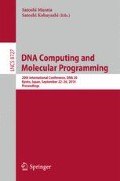Abstract
We propose a new computing model called chemical reaction automata (CRAs) as a simplified variant of reaction automata (RAs) studied in recent literature ([7-9]).
We show that CRAs in maximally parallel manner are computationally equivalent to Turing machines, while the computational power of CRAs in sequential manner coincides with that of the class of Petri nets, which is in marked contrast to the result that RAs (in both maximally parallel and sequential manners) have the computing power of Turing universality ([7-9]). Intuitively, CRAs are defined as RAs without inhibitor functioning in each reaction, providing an offline model of computing by chemical reaction networks (CRNs).
Thus, the main results in this paper not only strengthen the previous result on Turing computability of RAs but also clarify the computing powers of inhibitors in RA computation.
Access this chapter
Tax calculation will be finalised at checkout
Purchases are for personal use only
Preview
Unable to display preview. Download preview PDF.
References
Calude, C.S., Pun, G., Rozenberg, G., Salomaa, A. (eds.): Multiset Processing. LNCS, vol. 2235. Springer, Heidelberg (2001)
Csuhaj-Varju, E., Ibarra, O.H., Vaszil, G.: On the computational complexity of P automata. Natural Computing 5, 109–126 (2006)
Csuhaj-Varju, E., Vaszil, G.: P automata. In: The Oxford Handbook of Membrane Computing, pp. 145–167 (2010)
Ehrenfeucht, A., Rozenberg, G.: Reaction systems. Fundamenta Informaticae 75, 263–280 (2007)
Fischer, P.C.: Turing Machines with Restricted Memory Access. Inform. and Contr. 9(4), 364–379 (1966)
Hopcroft, J.E., Motwani, T., Ullman, J.D.: Introduction to automata theory, language and computation, 2nd edn. Addison-Wesley (2003)
Okubo, F.: Reaction automata working in sequential manner. RAIRO Theoretical Informatics and Applications 48, 23–38 (2014)
Okubo, F., Kobayashi, S., Yokomori, T.: Reaction automata. Theoretical Computer Science 429, 247–257 (2012)
Okubo, F., Kobayashi, S., Yokomori, T.: On the properties of language classes defined by bounded reaction automata. Theoretical Computer Science 454, 206–221 (2012)
Peterson, J.L.: Petri Net Theory and the Modeling of Systems. Prentice-Hall, Englewood Cliffs (1981)
Qian, L., Soloveichik, D., Winfree, E.: Efficient Turing-Universal Computation with DNA Polymers. In: Sakakibara, Y., Mi, Y. (eds.) DNA 16. LNCS, vol. 6518, pp. 123–140. Springer, Heidelberg (2011)
Soloveichik, D., Cook, M., Winfree, E., Bruck, J.: Computation with finite stochastic chemical reaction networks. Natural Computing 7(4), 615–633 (2008)
Suzuki, Y., Fujiwara, Y., Takabayashi, J., Tanaka, H.: Artificial Life Applications of a Class of P Systems: Abstract Rewriting Systems on Multisets. In: Calude, C.S., Pun, G., Rozenberg, G., Salomaa, A. (eds.) Multiset Processing. LNCS, vol. 2235, pp. 299–346. Springer, Heidelberg (2001)
Thachuk, C., Condon, A.: Space and energy efficient computation with DNA strand displacement systems. In: Stefanovic, D., Turberfield, A. (eds.) DNA 18. LNCS, vol. 7433, pp. 135–149. Springer, Heidelberg (2012)
Author information
Authors and Affiliations
Editor information
Editors and Affiliations
Rights and permissions
Copyright information
© 2014 Springer International Publishing Switzerland
About this paper
Cite this paper
Okubo, F., Yokomori, T. (2014). The Computational Capability of Chemical Reaction Automata. In: Murata, S., Kobayashi, S. (eds) DNA Computing and Molecular Programming. DNA 2014. Lecture Notes in Computer Science, vol 8727. Springer, Cham. https://doi.org/10.1007/978-3-319-11295-4_4
Download citation
DOI: https://doi.org/10.1007/978-3-319-11295-4_4
Publisher Name: Springer, Cham
Print ISBN: 978-3-319-11294-7
Online ISBN: 978-3-319-11295-4
eBook Packages: Computer ScienceComputer Science (R0)

